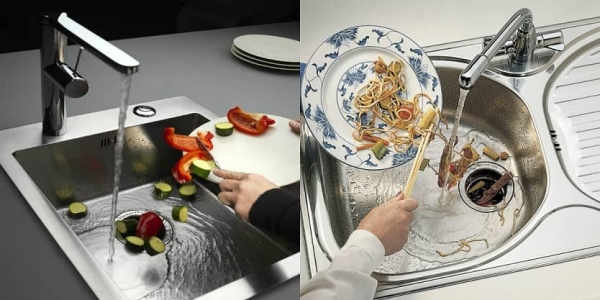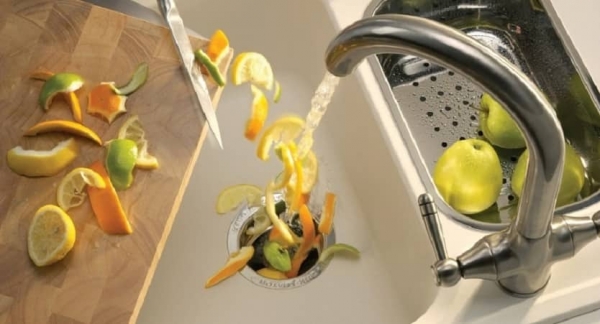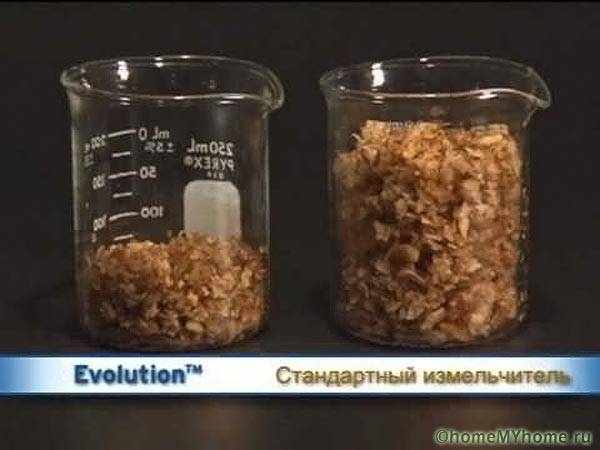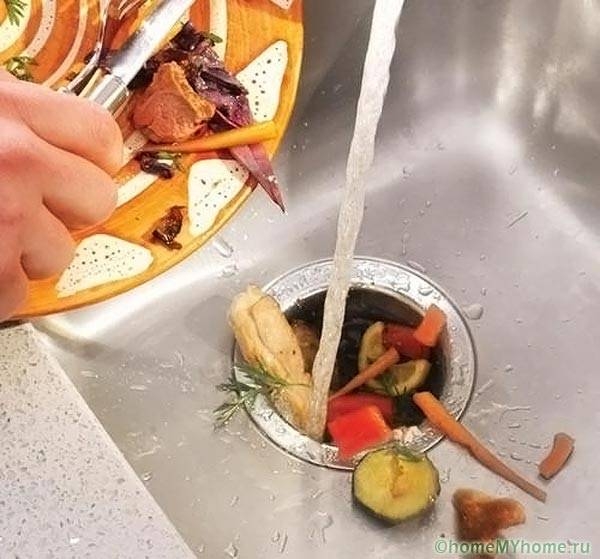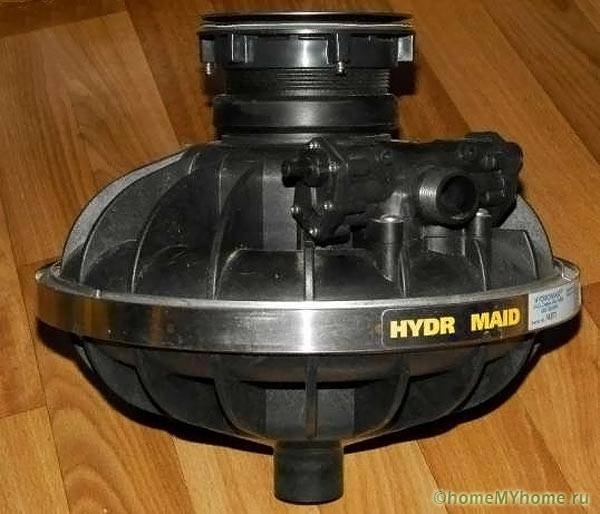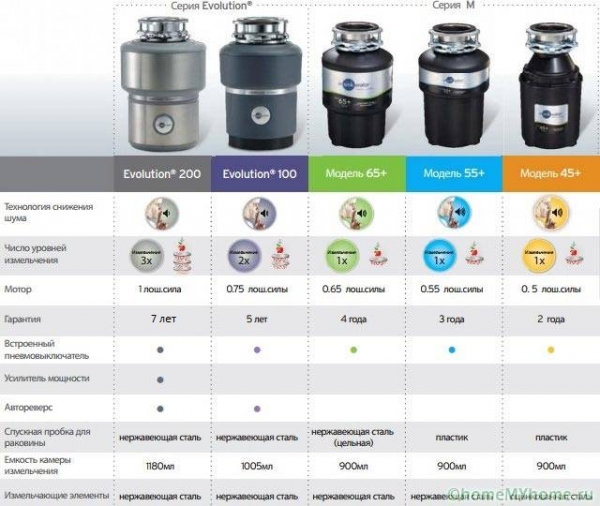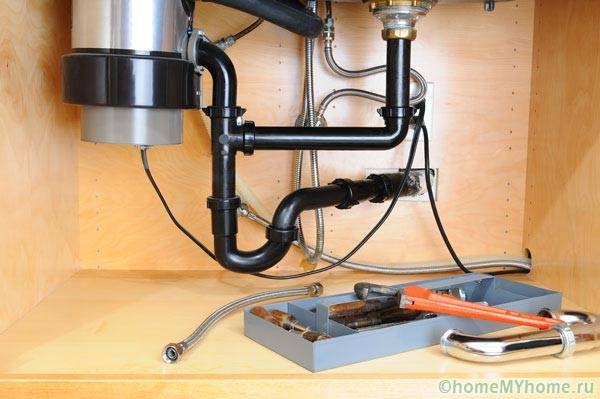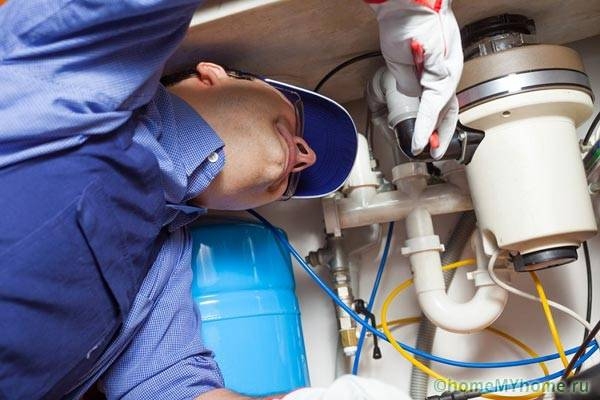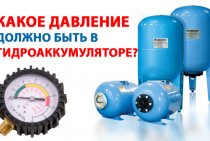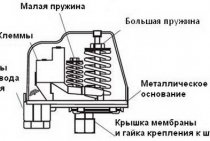Types of food waste grinders
To date, there are 2 types of dispensers on the market for household appliances for the kitchen. Each has its own characteristics of work, advantages and disadvantages.
hydraulic disposer
Such models are very unpretentious and quite reliable. They are powered by the flow of water, hence the name. The principle of operation is simple: the user opens the faucet and water flows through the grinder, setting it in motion.
Among the positive qualities of the device can be noted its efficiency. It does not require the use of electrical energy to operate. Another of its good sides is its almost silent operation. On this, perhaps, the pluses end.
The biggest downside to hydraulic shredders is that you can't turn it off at will. It will work whenever you turn on the faucet. So it pays to keep an eye on what you put in the sink. Otherwise, the dispenser can crumble into porridge what you didn’t plan to “feed” to it at all.
If you live on the top floor and your house has problems with the water supply, this dispenser will not work for you. It simply will not be able to work due to low pressure in the pipes. In addition, the hydraulic waste shredder is not very powerful. It can break if chicken bones or fruit bones are loaded into it.
Electric dispenser
Only a specialist should install such a device. After all, the electric dispenser has direct contact with both water and electricity at the same time.
Electric models are quite powerful and can handle not only soft food waste, but even small bones from fish or chicken. The advantage of such dispensers is that you can turn them on and off as you wish. They have nothing to do with the pressure of water in the tap and will work when you want it.
Electrodisposers also have disadvantages. First of all, it is quite noisy work. Not everyone will like the sound of the motor that sets the device in motion. The arrangement of such a chopper involves the output of a control button. Sometimes for its equipment it is necessary to drill an additional hole in new countertop or "pick" the wall. And of course, such a grinder consumes additional electricity. You will not spend much, but it is, nevertheless, an additional expense.
How does a kitchen waste disposer work?
The principle of operation of a household dispenser is quite simple. With the help of special devices, he grinds the food particles that fall into him into a fine gruel. After that, the resulting mass is washed off with a stream of water into the central sewer.
The unit is located under the kitchen sink. It must be installed in place of the siphon and equipped with a drain into the sewer. The design includes only two key elements:
- drive unit;
- grinding chamber.
Contrary to popular belief imposed on us by Hollywood films, the device does not have any monstrous knives. Inside the chamber there are freely “floating” hammers, which, when moving, rotate and rub against the ribbed walls of the reservoir surface. Thus, the waste is rubbed against the inner surface of the chamber and descends into the sewer pipe.
Main selection criteria
In order to purchase the most suitable food waste disposer, you need to know what you should pay attention to.
Power
This indicator is important for electric models. After all, you want to spend as little as possible, but at the same time not lose quality. For a young family of 2-3 people, a 550-600 watt dispenser is enough. But this is the case if you do not plan to load everything into it.Models that can “gnaw” even large bones or nutshells consume at least 1300 watts from the network. And such an indicator can not be called economical.
Chamber volume
It all depends on the previous point. The more powerful the engine of your chopper, the larger the crushing chamber. Too small devices are definitely low-power and not suitable for everyone.
Of course, when choosing, you should pay attention to the fact that the device fits freely under the sink.
Rotation speed of hammers (knives)
In hydraulic models, this indicator directly depends on the water pressure in the tap
For electric ones, you should pay attention to an indicator of at least 1400 rpm. The faster the hammers spin, the more waste you can recycle
materials
The ideal option is stainless steel. This is not only a fairly strong material, it is also not subject to corrosion. An alternative may be a metal-plastic case with an anti-corrosion coating inside.
To make the most correct choice, you should additionally pay attention to the presence of such options:
- the presence of additional sound insulation;
- possibility of reverse rotation;
- ability to work in several speed modes;
- built-in overload protection;
- reinforced drain flange;
- a guarantee of safety in the form of a long tube for feeding waste into the grinder;
- the presence of additional conditions for placement in relation to the sewer drain;
- the need to clean the device only with special branded products;
- maintainability and availability of service departments in your city.
TOP 3 popular models
In conclusion of our article, we present to your attention a small rating of food waste shredders, which have gained the most popularity according to user reviews.
InSinkErator Evolution 200
Incredibly powerful and roomy dispenser. An engine power of about 0.6 kW and a working chamber of 1.2 liters allow processing a fairly large amount of waste. The design provides for the Jam-Sensor Circuit system, which allows, if necessary, to increase the rotation of the engine by 500%. All parts of the structure are made of stainless steel, there is a built-in overload protection. Despite the fact that the model is electric, the noise of the engine is almost inaudible. The only drawback of this model may be a rather high cost. But if you believe the reviews, everything pays off quickly enough.
Zorg ZR-75D
Another fairly popular grinder for kitchen waste. With an engine power of 0.75 kW, it has a processing chamber with a volume of 1.2 liters. The rotation speed of the working disk is 2600 rpm, which allows you to cope with small bones and eggshells. Zorg ZR-75 D has a specially designed noise suppression system and an automatic reverse system. Compared to the previous model, it is very affordable.
STATUS Premium 300
Another pretty good model completes our small rating of shredders. The system is equipped with a special anti-vibration ring. This minimizes the load on stone and porcelain stoneware sinks. It has a three-level grinding system and a continuous feeding system. According to user reviews, the STATUS Premium 300 is not too noisy and does the job perfectly.
We really hope that our article will help you choose the right food waste disposer for your sink. After a short time, the dispenser will become simply irreplaceable for you.
Why do you need a disposer
It is impossible to cook dinner without leaving some waste behind. Most often, for their disposal, housewives use plastic bags placed in the trash can.
Those who are conscious of the environmental component place special containers in their kitchens, and they approach the issue of waste disposal as responsibly as possible.Plastic, glass and paper are recycled, but food waste has to be taken to the trash.
In order to get rid of unpleasantly smelling food residues as quickly as possible, a kitchen utilizer was invented. Of course, you still have to go to the yard container. However, you will do this much less often.
The only drawback of such a device is that not all waste can be put into it. Sufficiently soft potato peelings are quite “too tough” for him. But hard bones from peaches or apricots should not be sent there.
Principle of operation, device, selection criteria
In the food waste grinder for the sink, crushing takes place, then grinding the organic matter to a paste-like state (fraction 5 - 3 mm).
Type of ground food waste
To move the resulting mass through the sewer, it is necessary to turn on the water from the tap, maintaining a small jet until the waste is completely ground.
The dispenser will do its job well with the water turned on.
Mechanical (hydraulic) grinder
Mechanical dispensers start working from the pressure of water every time the tap is turned on. Instead of rubbing waste against the walls of the chamber with fists, cutting of bones takes place here, cleaning with several knives. The device is non-volatile, however, it will not turn on at a low pressure of less than 2.5 atmospheres. But the hydraulic equipment works almost silently.
hydraulic shredder
A food waste hydrochopper is more expensive than its electric counterparts. This is due to a more complex device, expensive components. The operation of these devices in families with small children is not recommended due to the increased risk of injury. Knives are blocked only when metal objects or glass penetrate into the chamber. If the pressure in the water supply is not stable, the built-in appliances will be useless.
Household Hydraulic Food Waste Disposer
Electric dispenser
The food waste electric disposer is cheaper (household models only), but you will need a waterproof outlet to connect. Most manufacturers produce only volatile household appliances, so the range is much wider.
Varieties of electric dispensers
When choosing, they are mainly guided by the drive power. The volume of the crushing chamber is not so important - peak loads traditionally fall on anniversaries, weddings, the pickle season. In principle, a 0.5 kW engine is enough for a small family. Moreover, an increase in loads cannot cause burnt windings - thermal protection will work, the drive will turn off.
Electrical dispenser piping
The maintainability of electric, hydraulic models is approximately the same. However, the operating budget of the latest options is much lower - rewinding the engine is more expensive than replacing knives, and no electricity is consumed. Water as a drive is the cheapest energy carrier.
Chopper repair
Finally, for suburban dwellings, the grinder is not relevant in principle. The family either keeps livestock/poultry or uses the organics in the compost heaps.
Chopper care
The food waste disposer is essentially a self-cleaning device. But still, he needs to be taken care of.
- From time to time, during operation of the device, turn on not cold water, but warm. This will help get rid of greasy deposits that accumulate on the walls of the device.
- Never turn off the faucet immediately after turning off the dispenser. Let the water run for a few more seconds. This will allow you to remove the smallest particles of ground food into the sewer as much as possible.
- Regularly pour lemon zest and cubes of frozen soda solution into the grinder. This will help to avoid unpleasant odors from the drain hole.
- When installing the device, try not to use a corrugated pipe.Particles of waste can get stuck in its folds, which can subsequently lead to blockage.
- Once or twice a year, pour a special cleaning agent specifically designed for recyclers into the sink. It will help to clean the unit from plaque, unpleasant odors and germs.
